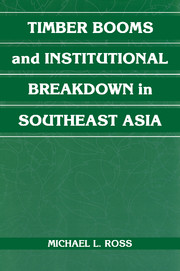Book contents
- Frontmatter
- Contents
- Illustrations
- Tables
- Preface
- 1 Introduction: Three Puzzles
- 2 The Problem of Resource Booms
- 3 Explaining Institutional Breakdown
- 4 The Philippines: The Legal Slaughter of the Forests
- 5 Sabah, Malaysia: A New State of Affairs
- 6 Sarawak, Malaysia: An Almost Uncontrollable Instinct
- 7 Indonesia: Putting the Forests to “Better Use”
- 8 Conclusion: Rent Seeking and Rent Seizing
- Appendix: Chronologies of Events
- References
- Index
6 - Sarawak, Malaysia: An Almost Uncontrollable Instinct
Published online by Cambridge University Press: 30 July 2009
- Frontmatter
- Contents
- Illustrations
- Tables
- Preface
- 1 Introduction: Three Puzzles
- 2 The Problem of Resource Booms
- 3 Explaining Institutional Breakdown
- 4 The Philippines: The Legal Slaughter of the Forests
- 5 Sabah, Malaysia: A New State of Affairs
- 6 Sarawak, Malaysia: An Almost Uncontrollable Instinct
- 7 Indonesia: Putting the Forests to “Better Use”
- 8 Conclusion: Rent Seeking and Rent Seizing
- Appendix: Chronologies of Events
- References
- Index
Summary
There is in man an almost uncontrollable instinct to destroy forests … with the rapid expansion of these industries a strong possibility of such a danger can be clearly foreseen.
Sarawak Forest Conservator F. G. Browne (1954: 33)Sarawak is Malaysia's largest state, and has almost twice Sabah's forested area. Some 17 percent of Sarawak's forests lie along the coasts, and are classified as peat swamp and mangrove forests. The balance lies in the lowlands and uplands of the hilly interior.
The peat swamp forests hold valuable stands of ramin trees, which have been harvested commercially since the late 1940s. But the soils of the hill forests are relatively poor, compared with the rich volcanic soils of the Philippines, Sabah, and East Kalimantan (in Indonesia). Sarawak's hill forests yield less exportable timber per hectare than the other three regions, and was the last to undergo a major logging boom.
On joining the Malaysian Federation in 1963, Sarawak – like Sabah – retained autonomy over its forests. Yet when the timber industries of the Philippines, Sabah, and Indonesia boomed in the 1950s, 1960s, and early 1970s, Sarawak's timber industry remained small, since its less valuable forests could not yet be profitably logged.
But in the late 1970s, both Philippine and Indonesian log exports began to fall, producing a demand for Sarawak logs to feed the plymills of Japan, South Korea, and Taiwan. From 1975 to 1985, Sarawak's share of the international hardwood log market rose from 3.4 percent to 38 percent.
- Type
- Chapter
- Information
- Timber Booms and Institutional Breakdown in Southeast Asia , pp. 127 - 156Publisher: Cambridge University PressPrint publication year: 2001
- 1
- Cited by



